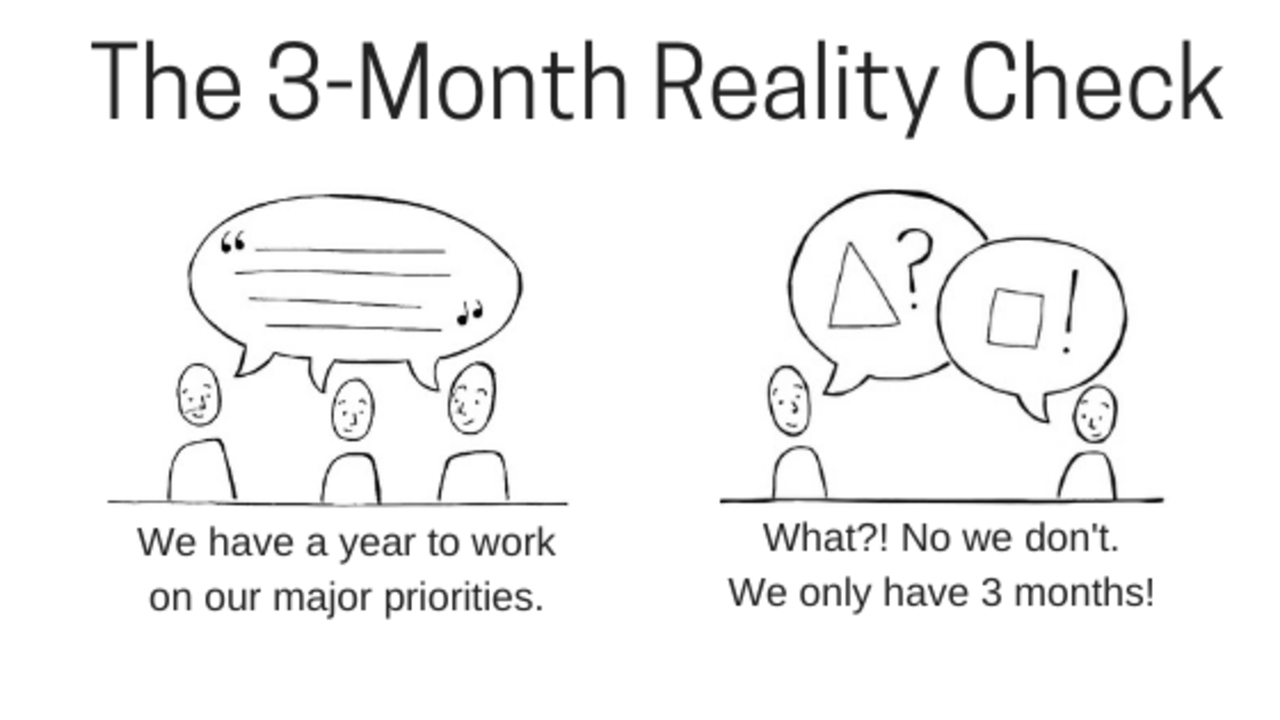Implementation Challenge: The Three-Month Reality Check

December 13, 2019
Many campuses have either struggled to maintain momentum or stalled all together in their efforts to plan and implement major priorities to improve the student experience with equity impact. There's the usual suspects that contribute to a lack of clarity, coherence, and consensus: endless "inquiry" (i.e., data analysis, a tactic to avoid the work); hubris; workgroups that lack purpose and project management expertise; poorly designed structures that fail to communicate, collaborate, and integrate together; unproductive governance structures; hubris; indecisive leadership; lack of an external perspective; and outright sabotage. Did I mention hubris? But there's rarely a reality check of how many months a typical campus truly has to get quality work done: Three. Yes, three!
Let's take a culture-changing framework such as Guided Pathways. California, for example, provided community colleges substantial funding to implement Guided Pathways in 60 months. Given my 3-month rule, most campuses really only had 15 months to implement significant changes to improve the student experience. Throw in a pandemic, Guided Pathways saboteurs, the dysfunction mentioned above, and it's no wonder many colleges accomplished so very little. Kudos to the colleges that accomplished significant student-centered change with equity impact despite the overwhelming odds.
That said, here's how much time a typical campus has to plan and implement significant priorities with the usual responses:
June, July, August: "Our campus goes dark. Nothing happens."
September: "It's too hectic with the start of the semester."
October: "This month is good to concentrate on new priorities."
November, December: "Not good. With the Holidays and people going on break, we're lucky to squeeze in 2 meetings."
January: "Most people don't return to campus until late January."
February: "We're too busy with the start of the spring semester."
March: "This month is good to concentrate on new priorities."
April: "OK month, but it's spring break."
May: "Too busy with end-of-year activities"
October, March, and April could be devoted to quality work at a typical campus. That's it!
How do we problem-solve the time constraint challenge? Don't be a typical campus!
Consider the following summer and winter session activities:
1. Hold virtual mini-retreats.
2. Attend workshops and/or webinars with colleagues.
3. Have lunch with colleagues from other campuses to share promising practices.
4. Provide modest stipends for faculty to attend important planning meetings.
Campuses that halt important priorities over the summer and winter session inevitably lose momentum. Key decisions don't have to be made during the summer and winter, but find ways to be productive in those critical months.
In terms of the other months, consider the following tips:
- When you create structures specific to major reform efforts, ensure that the workgroups are scheduled to meet at least three times a month.
- Don't shoot for 100% workgroup attendance. 60%-70% is fine and DO NOT spend a lot of time in the meeting bringing people up-to-speed on what happened at the previous meeting (that's what emailed meeting minutes are for).
- It can be highly situational, but for the most part, DO NOT seek unanimity at workgroup meetings. General consensus is fine.
- Use video conferencing technology to give people flexibility to meet.
- Make sure there's a share back to a larger body and across workgroups so that workgroups don't become silos.
- Ensure there's a prep meeting with an agenda. People are likely to disengage from the work if their time is wasted with unproductive meetings.
- Start and end the meetings on time. Honor those who made it to the meeting on time, and respect that people need to get to other meetings on time.
For those of you shepherding priorities at your campus, consider the following leadership dispositions. They can mean the difference between the work continuing or stalling*:
- Toughen and thicken your skin
- Grow and refine your patience
- Guard and maintain your hope
- Exercise, but monitor, your license to lead
- Disinvite and disinvolve your ego
- Fear not the evaluation of your efforts
- Clarify, re-clarify, and remember your focus
- Leverage pedagogy (Keep asking yourself as you articulate activities and goals, "How do I teach this well?")
- Treat people with kindness
Student success rates along the student journey are often less than 50% (single digits at some campuses). We need to think creatively about how to make the best use of our time, and leverage leadership dispositions in order to maintain momentum. There's too much at stake if we fail to problem-solve decades-old time constraint challenges.
***
Also visit: What's Needed To Improve Student Outcomes | Transformational Change | Blocking Student Success & Equity Work
*Thanks to my dear friend, Dr. Bill Saunders, for these leadership dispositions. I added the last two.






